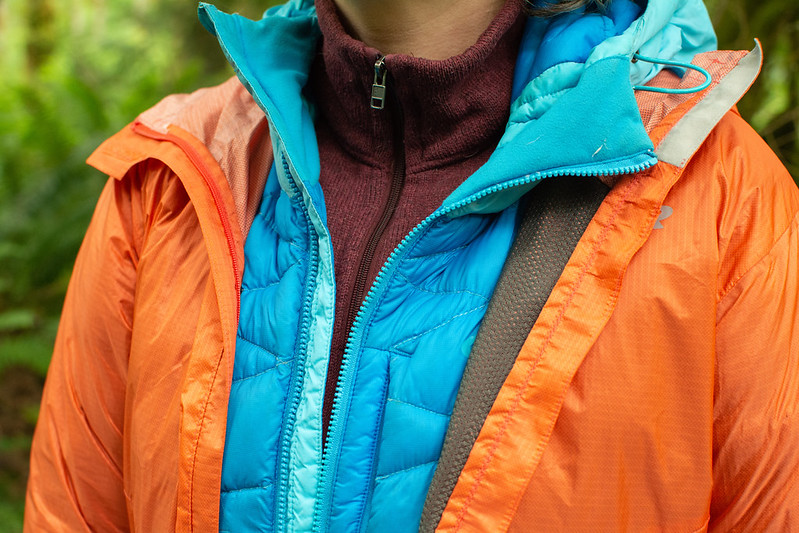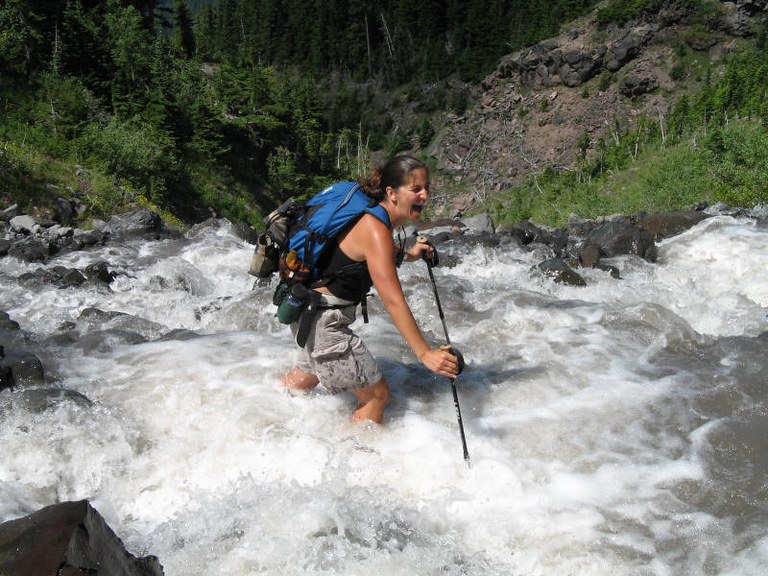Spring Hiking Tips
Spring is the time when the forest shakes off its winter doldrums and starts to come alive. Fern fronds unfurl, cottonwood trees broadcast perfume, and trillium, balsamroot and skunk cabbage brighten the way. The weather can be wacky with marbled skies serving up bursts of sun and rain showers in the same hour.

Yay for green! Photo by Kerry Valentine.
Hikers, too, are coming out of hibernation; spring hikes are often the first outing since the previous summer. It's a good idea to freshen up on general hiking safety, while considering a few conditions unique to spring. Because many trails have been under feet of snow and covered with fallen branches and trees, conditions can be unpredictable.
The following spring hiking tips will help you get back into the hiking frame of mind after a long winter and discuss the state of trails in spring.
Be Prepared
Many hikers will admit that they sometimes forget to pack an important item in their backpack, especially in the spring when they are a bit out of practice. Refresh your memory of what the essentials are by using our packing list. (Hint: Some of these are particularly important for spring hiking!)
- Adequate extra clothing. While it may be pleasant when you begin your hike, spring weather in Washington is notorious for changing quickly and dramatically. Rainstorms happen unexpectedly, and winds can be mighty cold atop ridges or at lakes.
Bring clothing layers made of materials that wick sweat and moisture away from your body, such as wool or synthetics (not cotton). Pack your raincoat no matter the forecast and throw in a pair of extra socks, should yours get wet. You also might consider investing in gaiters to keep your legs dry. They're particularly useful when crossing streams and brushing up against wet plants.

So many layers. Photo by Erika Haugen-Goodman.
- Map and compass. Hikers should always carry these items, but in the spring they are especially important because hazards like snow and blowdowns can obscure an otherwise obvious trail.
- First aid kit. When was the last time you looked at your first aid kit? Spring is the time to open it up and replenish bandages, antiseptic wipes and more. You'll be happy you did when the first blister appears.
- Food and water. Hiking makes you hungry and thirsty. Don't skimp on food and water.

Columbia Hills is a great spot for catching spring wildflowers in Washington. Photo by Bob and Barb.
Choosing Your Destination
The perennial spring hiking question is: Where's the snow? Or rather, where is there not snow? Snow can stick around in the mountains here well into July — so you're likely to run into some if you're heading out on a springtime hike.
Note: Thinking of doing some spring snowshoeing? Check out our late winter and avalanche safety tips before heading out.
Consult Trip Reports
WTA's trip reports are the best guide to what conditions are like on a specific trail right now. Check these reports for inspiration about where to hike and to find out what you may encounter on trail. And when you get back, write one of your own! The system is as good as you make it.
Contact Ranger Stations
The closest ranger station is another go-to resource. Call ahead and talk to a ranger, who can give you advice and information about where you want to go. Find phone numbers for all the major land management agencies here.
Check Weather and Snow Conditions
There are many excellent weather resources available to hikers.
Each hiking guide entry on our site has a link to the forecast for the area the hike is located. You can also consult the National Weather Service's mountains forecast page. It provides a detailed forecast for hiking destinations (not just towns and cities) throughout Western Washington.
The other must-read website is produced by the Northwest Weather and Avalanche Center (NWAC). It provides avalanche forecasts, as well as an hour-by-hour look at temperature, wind, precipitation and snow that goes back 10 days. The latter can be hard to find on the website, so use this link for Snoqualmie Pass. (There are other locations as well).
See some Suggested Hikes
wta.org is full of suggestions for spring hiking. Try a wildflower hike. Or a desert hike in Central Washington; we have lots of suggestions for spring hiking. If you hear of a hike you're interested in, find it in WTA's Hiking Guide.
Hazards of Spring Hiking
Snow. Rain. Mud. Blowdowns. Nasty roads. All these are hazard of spring hiking. But snow melts. Rainy skies give way to sunny ones. Trail crews remove downed trees and fix muddy spots on the trail. And if we're lucky, roads get fixed. In the meantime, here's how to handle these hazards should you encounter them.
Snow
Snow is slick (especially in the morning after it has frozen overnight). Alternately, it can be soft (postholing is common). If there's a lot, it can obscure an otherwise obvious trail, and changing conditions can trigger an avalanche or collapse a snow cornice. Yikes. Luckily, WTA has compiled a list of snow-travel tips that you will want to review.
Hikers who want to push on through snow should come prepared with snowshoes, or traction devices for their boots and good route-finding skills. If your hike involves a lot of elevation gain, you may have to worry about avalanche danger. If you're not sure it's safe, use common sense. As tempting as it can be to finish the hike, remember that the trail will be there for you try again another day. Hike safely.
Water
You'll have to contend with both rain and streams in spring hiking. To stay dry, carry rain gear and a change of clothes. You'll be glad for something to change into if things get real damp. While you stay pretty warm when you're moving, it's easy to get chilled once you slow down or are standing still.

Spring means snowmelt, snowmelt means high water in creeks. Photo by Holly Donovan.
As the weather warms up and snow begins to melt stream crossings become more challenging and potentially dangerous. WTA has detailed the best way to ford a river or stream. Watch the video for more information. Watch your step when you cross; wet logs and rocks can be slippery.
Mud and Blowdown
Mud and blowdowns (trees that have fallen over in storms) are standard in northwestern winters. They're the two most common trail issues that WTA's trail maintenance team of volunteers combat each year. What happens, however, when you hit the trail before a trail crew can get out and fix it?
If you can, slog right through that mud or under that downed tree. When hiker after hiker tries to skirt a problem spot, fragile meadows are liable to be damaged. Keep your balance in these and other slick spots with trekking poles. And when navigating a blowdown obstacle course, watch out for protruding sticks. They can tear gear or poke eyes.
Nasty Roads
It's also important to check road conditions before heading out on your hike. Many are gated in winter and may not have been opened yet. Others are potholed or still covered in a layer of snow, not suited for the family sedan. Still, others are closed due to flood damage or road conditions. Ranger station websites are the best resource for road conditions. You can access the one you need from here.
Ticks
Spring, unfortunately, also happens to be tick season. These frightful pests are found in Washington State, but don't let them deter you from having a great hike. Our tips for hiking in tick country cover everything you need to know to feel confident if you do come across them.


